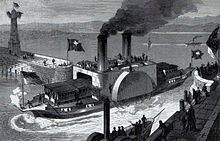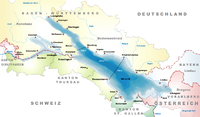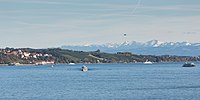
Lake Constance refers to three bodies of water on the Rhine at the northern foot of the Alps: Upper Lake Constance (Obersee), Lower Lake Constance (Untersee), and a connecting stretch of the Rhine, called the Lake Rhine (Seerhein). These waterbodies lie within the Lake Constance Basin in the Alpine Foreland through which the Rhine flows.
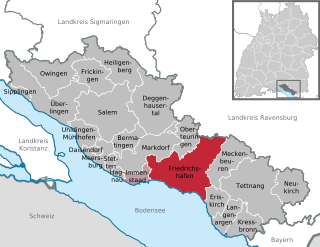
Friedrichshafen is a city on the northern shoreline of Lake Constance in Southern Germany, near the borders of both Switzerland and Austria. It is the district capital (Kreisstadt) of the Bodensee district in the federal state of Baden-Württemberg. Friedrichshafen has a population of about 58,000.
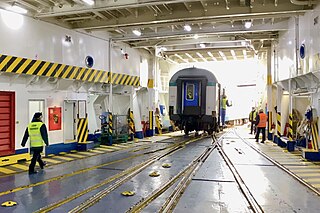
A train ferry is a ship (ferry) designed to carry railway vehicles. Typically, one level of the ship is fitted with railway tracks, and the vessel has a door at the front and/or rear to give access to the wharves. In the United States, train ferries are sometimes referred to as "car ferries", as distinguished from "auto ferries" used to transport automobiles. The wharf has a ramp, and a linkspan or "apron", balanced by weights, that connects the railway proper to the ship, allowing for tidal or seasonal changes in water level.

The High Rhine Railway is a Deutsche Bahn railway line from Basel Badischer Bahnhof in the city of Basel to Konstanz on Lake Constance. It was built by the Grand Duchy of Baden State Railways as part of the Baden Mainline, which follows the Rhine upstream from Mannheim Hauptbahnhof to Konstanz. The line derives its name from the High Rhine, which it follows between Basel and Waldshut and on a short section in Schaffhausen.

The Ulm–Friedrichshafen railway, also known as the Württembergische Südbahn, is an electrified main line in the state of Baden-Württemberg, southern Germany. It was built from 1846 to 1850 and doubled from 1905 to 1913. During that time many of the station buildings were rebuilt. Its kilometre numbering (chainage) begins as the Fils Valley Railway in Stuttgart Hbf. The line was upgraded and electrified from the spring of 2018. Electric operations commenced in December 2021.

The Swiss Northeastern Railway was an early railway company in Switzerland. It also operated shipping on Lake Constance (Bodensee) and Lake Zürich. Until the merger of the Western Swiss Railways into the Jura–Simplon Railway (JS) in 1890/91, it was the largest Swiss railway company.

The Lake Line, as it is referred to by the SBB in English, is the Swiss railway line running from Rorschach via Romanshorn, Konstanz (Germany), Kreuzlingen, Steckborn, Stein am Rhein and Diessenhofen to Schaffhausen. The scenic route follows the southern border of Lake Constance and the High Rhine. It forms the Swiss section of the ring railway around Lake Constance.

Konstanz station is the largest passenger station in the German city of Konstanz (Constance). It is served by regional and long-distance services operated by Deutsche Bahn and Swiss Federal Railways. It is the end of the High Rhine Railway and the beginning of the Lake Line.
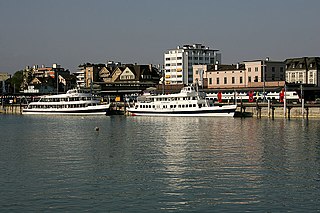
Romanshorn railway station is a railway station that serves the municipality of Romanshorn, in the canton of Thurgau, Switzerland. Opened in 1855, the station is owned and operated by SBB-CFF-FFS. It forms the junction between the Winterthur–Romanshorn railway, the Schaffhausen–Rorschach railway and the Romanshorn–Nesslau Neu St. Johann railway.

Lindau-Insel station is the largest station in the city of Lindau (Bodensee) and was its most important station until passenger service resumed at Lindau-Reutin station on December 13, 2020. In the urban area there is also Lindau-Aeschach station and Lindau-Reutin freight yard. Formerly there were also Lindau-Siebertsdorf, Lindau Langenweg, Lindau Strandbad, Schoenau, Oberreitnau and Rehlings.
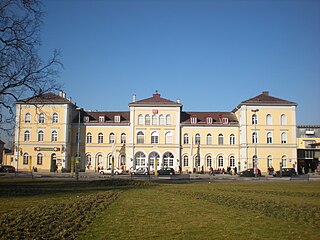
Friedrichshafen Stadt (city) station is the largest railway station of the city of Friedrichshafen on Lake Constance (Bodensee) and a railway junction in the German state of Baden-Württemberg. It has five tracks and is classified by Deutsche Bahn as a category 3 station. Each day it is used by about 160 trains operated by Deutsche Bahn and the Bodensee-Oberschwaben-Bahn (BOB). Ulm–Friedrichshafen railway from Ulm ends at the station, where it meets the Stahringen–Friedrichshafen railway and the Friedrichshafen–Lindau railway. Another major railway station in the city, Friedrichshafen Hafen station, which is operated as part of Friedrichshafen Stadt station, was used until 1976 for loading and unloading carriages on the Lake Constance train ferry to Romanshorn in Switzerland.
The Lake Constance Belt Railway is a name used for several contiguous railway lines around along the northern shore of Lake Constance (Bodensee) in southern Germany. It was coined around 1900, when the railway ring around the lake was finished, and consists of the following sections:

The Stadt Zürich was a Swiss steamship, built in 1855, that plied Lake Constance. She was given the nickname Teufelsschiff because she was involved in three serious collisions with other craft and was said to have sunk more German ships than the Danish navy during the Second Schleswig War.
The Jura was a wooden, flush deck, paddle steamer, originally built for service on Lake Neuchâtel, but which was sold after seven years to work on Lake Constance, and sank in 1864 after a collision with the Stadt Zürich.
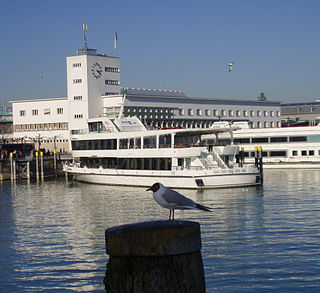
The Friedrichshafen Stadt–Friedrichshafen Hafen railway is a standard gauge and electrified railway line in the city of Friedrichshafen in the German state of Baden-Württemberg. It connects the town station with the port station. The 816 metre-long branch line has its own VzG route number, 4531, although operationally it is a connection between two parts of the same station.

Friedrichshafen Hafen station is a station in Friedrichshafen in the German state of Baden-Württemberg. It was opened on 1 June 1850 and served as a port station for the train ferry over Lake Constance to Romanshorn until 1976 and is still used for passenger services by Deutsche Bahn and Bodensee-Oberschwaben-Bahn (BOB). Today Friedrichshafen Hafen station is administered as a part of the Friedrichshafen Stadt station (Stadtbahnhof), to which it is connected by the Friedrichshafen Stadt–Friedrichshafen Hafen railway.

The Winterthur–Romanshorn railway, also known in German as the Thurtallinie, is a Swiss railway line and was built as part of the railway between Zürich and Lake Constance (Bodensee). It connects Winterthur with Romanshorn, where it formerly connected to train ferries over Lake Constance. It is the fourth oldest internal railway in Switzerland. Its construction was to be funded by the Zürich-Lake Constance Railway (Zürich-Bodenseebahn), but during the construction the company was merged with the Swiss Northern Railway to form the Swiss Northeastern Railway. The Winterthur–Romanshorn railway was opened on 16 May 1855 and the line from Winterthur to Oerlikon was opened on 27 December 1855. Zürich was reached on 26 June 1856 and the two existing NOB lines were connected.

The Vorarlberg S-Bahn is a label for regional rail services in the Austrian state of Vorarlberg. It is integrated into the Vorarlberg Transport Association (VVV) which manages ticket pricing, and is operated by the state-owned ÖBB and privately owned Montafonerbahn (mbs). In addition to Vorarlberg, the network connects to the German town of Lindau, the Swiss towns of St. Margrethen and Buchs SG, and stations in the Principality of Liechtenstein.

Rorschach Hafen railway station is a railway station in Rorschach, in the Swiss canton of St. Gallen. It is located on the Lake line of Swiss Federal Railways. It is adjacent to a ferry terminal with service to Lindau and Wasserburg am Bodensee across Lake Constance.

The S7 is a railway service of the St. Gallen S-Bahn that provides half-hourly service between Romanshorn and Rorschach, with hourly service from Romanshorn to Weinfelden. Some trains continue from Rorschach to St. Margrethen, Bregenz and Lindau along the shores of Lake Constance.



